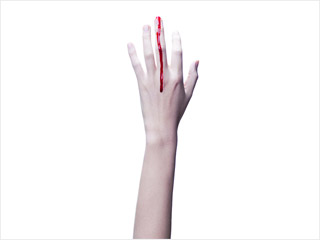Matthew Hashiguchi
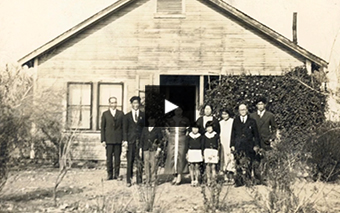 Good Luck Soup
Good Luck SoupIs a transmedia storytelling project documenting and sharing stories of the Japanese American and Japanese Canadian experience after they left the internment camps. The project consists of a feature-length documentary film, titled Good Luck Soup and an interactive, participatory website, Good Luck Soup Interactive. On this website stories will be told through uploaded text and photographs from internment camp victims, or their families, and will be shared through an interactive website and map.
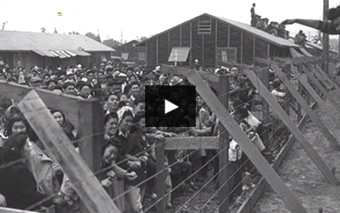 People Aren't All Bad
People Aren't All BadZZ. What has been the reaction of the public to your invitation to participate in your transmedia storytelling project?
MH. We've had a consistently positive response from the Japanese American/Canadian community. Initially, I think many have been nervous about sharing their own stories and experiences, but once we sit down with them and talk about their life, they tend to open up. It's been a form of catharsis, I think, because many people have never discussed their issues or experiences of being Japanese American/Canadian... and some of these things are very difficult topics or thoughts that have been bottled up. So, it's a very emotional experience to share these thoughts and feelings. We haven't yet opened it up to the general public, but again, everyone has been consistently positive, and I have no reason to think the reaction will be any different once its available to all Japanese Americans and Japanese Canadians.
ZZ. What means of publicity are you using or are you planning to use for the diffusion of the project?
MH. Social media will be a huge tool for publicity and marketing. We've already reached and met so many people through Twitter and Facebook, and we'll certainly continue to utilize those outlets. We've been in communication with many Asian American and Asian Canadian organizations that have offered their support once the project is complete, and the opportunity to collaborate with entities such as the Japanese American Citizens League, the Japanese American National Museum and the Nikkei National Museum would be priceless. We're certainly inspired by their mission and view our project as a continuation of what they offer the public.
In addition to the interactive documentary, this project also includes a feature length film. Film festivals will be another great opportunity to screen the film and present the interactive project to an audience.
ZZ. Can you share with us how you have experienced the realisation, dissemination and the reach of the project thus far?
MH. It's been a very gradual and collaborative process, and luckily I have an incredible team of colleagues and friends that have made the realization of this project possible, and without their help, I would not have been able to get this project made. The work load is split up fairly well. Right now, our web-designer/coder (Russell Goldenberg) is building the site. He's the one sitting alone typing away at his computer. Every few weeks, we'll all have a meeting where we discuss the direction of the project... and then Russell goes and brings it to life. Billy Wirasnik, Emily Ferrier and myself and have been in charge of content aggregation. So we're narrowing the aim of the stories and in many cases, going out and finding those stories and individuals. It's a solid collaboration made up of various creative visions, rather than one. And, as the Project Creator, I really enjoy a hands-off approach that allows individuals to run off with an idea and make it their own.
 Matthew Hashiguchi (1984). Based in Boston, Massachusetts. After graduating from The Ohio State University in 2007 with a BA in Photojournalism, Matthew went on to work and intern as a multimedia journalist for The Findlay Courier, The Lima News and The Washington Post. In 2008, he returned to school and graduated from Emerson College with an MFA in Visual and Media Art and has since been working as an independent documentary filmmaker and educator, whose work focuses on the diverse cultural, social and ethnic stories of American society. For his film The Lower 9 he has received various awards.
Matthew Hashiguchi (1984). Based in Boston, Massachusetts. After graduating from The Ohio State University in 2007 with a BA in Photojournalism, Matthew went on to work and intern as a multimedia journalist for The Findlay Courier, The Lima News and The Washington Post. In 2008, he returned to school and graduated from Emerson College with an MFA in Visual and Media Art and has since been working as an independent documentary filmmaker and educator, whose work focuses on the diverse cultural, social and ethnic stories of American society. For his film The Lower 9 he has received various awards. Good Luck Soup
Good Luck SoupIs a transmedia storytelling project documenting and sharing stories of the Japanese American and Japanese Canadian experience after they left the internment camps. The project consists of a feature-length documentary film, titled Good Luck Soup and an interactive, participatory website, Good Luck Soup Interactive. On this website stories will be told through uploaded text and photographs from internment camp victims, or their families, and will be shared through an interactive website and map.
 People Aren't All Bad
People Aren't All BadZZ. What has been the reaction of the public to your invitation to participate in your transmedia storytelling project?
MH. We've had a consistently positive response from the Japanese American/Canadian community. Initially, I think many have been nervous about sharing their own stories and experiences, but once we sit down with them and talk about their life, they tend to open up. It's been a form of catharsis, I think, because many people have never discussed their issues or experiences of being Japanese American/Canadian... and some of these things are very difficult topics or thoughts that have been bottled up. So, it's a very emotional experience to share these thoughts and feelings. We haven't yet opened it up to the general public, but again, everyone has been consistently positive, and I have no reason to think the reaction will be any different once its available to all Japanese Americans and Japanese Canadians.
ZZ. What means of publicity are you using or are you planning to use for the diffusion of the project?
MH. Social media will be a huge tool for publicity and marketing. We've already reached and met so many people through Twitter and Facebook, and we'll certainly continue to utilize those outlets. We've been in communication with many Asian American and Asian Canadian organizations that have offered their support once the project is complete, and the opportunity to collaborate with entities such as the Japanese American Citizens League, the Japanese American National Museum and the Nikkei National Museum would be priceless. We're certainly inspired by their mission and view our project as a continuation of what they offer the public.
In addition to the interactive documentary, this project also includes a feature length film. Film festivals will be another great opportunity to screen the film and present the interactive project to an audience.
ZZ. Can you share with us how you have experienced the realisation, dissemination and the reach of the project thus far?
MH. It's been a very gradual and collaborative process, and luckily I have an incredible team of colleagues and friends that have made the realization of this project possible, and without their help, I would not have been able to get this project made. The work load is split up fairly well. Right now, our web-designer/coder (Russell Goldenberg) is building the site. He's the one sitting alone typing away at his computer. Every few weeks, we'll all have a meeting where we discuss the direction of the project... and then Russell goes and brings it to life. Billy Wirasnik, Emily Ferrier and myself and have been in charge of content aggregation. So we're narrowing the aim of the stories and in many cases, going out and finding those stories and individuals. It's a solid collaboration made up of various creative visions, rather than one. And, as the Project Creator, I really enjoy a hands-off approach that allows individuals to run off with an idea and make it their own.
 Matthew Hashiguchi (1984). Based in Boston, Massachusetts. After graduating from The Ohio State University in 2007 with a BA in Photojournalism, Matthew went on to work and intern as a multimedia journalist for The Findlay Courier, The Lima News and The Washington Post. In 2008, he returned to school and graduated from Emerson College with an MFA in Visual and Media Art and has since been working as an independent documentary filmmaker and educator, whose work focuses on the diverse cultural, social and ethnic stories of American society. For his film The Lower 9 he has received various awards.
Matthew Hashiguchi (1984). Based in Boston, Massachusetts. After graduating from The Ohio State University in 2007 with a BA in Photojournalism, Matthew went on to work and intern as a multimedia journalist for The Findlay Courier, The Lima News and The Washington Post. In 2008, he returned to school and graduated from Emerson College with an MFA in Visual and Media Art and has since been working as an independent documentary filmmaker and educator, whose work focuses on the diverse cultural, social and ethnic stories of American society. For his film The Lower 9 he has received various awards.Josef Wladyka
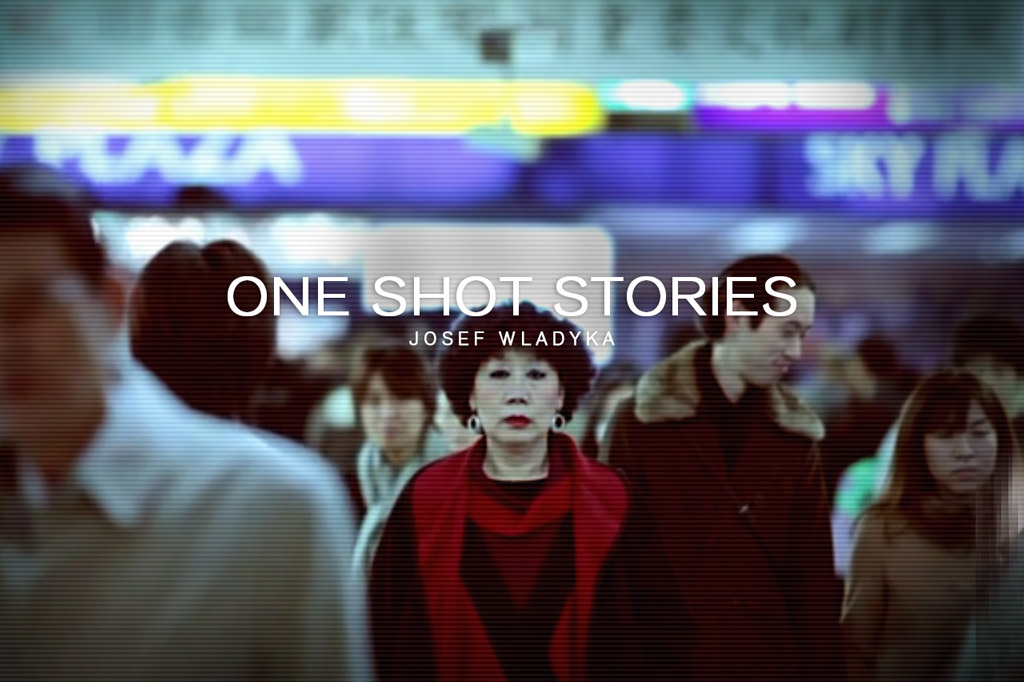
My mother left Japan more than thirty years ago and didn't return until November 2010. This is her story.
Location: Tokyo, Japan.
Cinematography: Stan Wladyka.
Music: Tyler Parkinson.
Okaasan お母さん
Beginning as a child performer in Odessa, Russia, Albert Makhtsier has been acting for over half a century. Despite being diagnosed with Parkinson's disease, Albert remains one of New York City's finest actors. This is his story.
Location: Times Square, New York City.
Cinematography: Alan Blanco.
Music: Tyler Cash.
Albert Makhtsier
Curai is a small, tight knit fishing village on the Southern Pacific Coast of Colombia. It's a place where almost everyone shares the same last name. Jacobo is a community leader there and this is one of his stories.
Location: Curai, Colombia.
Cinematography by Leonardo D'Antoni.
Music by Tyler Cash.
Jacobo Castillo Salazar
These are a collection of peoples' personal stories told through a single shot. Each story is an exploration of the universal essence of the human condition and our connection to one another that extends beyond any boundaries.
 Josef Wladyka. Lives in New York. Influenced by his parents, Josef developed a fascination for movies from a very young age. He began experimenting with filmmaking in high school and has since created several (short) films and commercials that have been screened at festivals around the world. He holds a MFA from NYU Tisch Graduate Film where he won a Spike Lee Fellowship. His debut feature film, Manos Sucias (2014), has won various awards.
Josef Wladyka. Lives in New York. Influenced by his parents, Josef developed a fascination for movies from a very young age. He began experimenting with filmmaking in high school and has since created several (short) films and commercials that have been screened at festivals around the world. He holds a MFA from NYU Tisch Graduate Film where he won a Spike Lee Fellowship. His debut feature film, Manos Sucias (2014), has won various awards.
My mother left Japan more than thirty years ago and didn't return until November 2010. This is her story.
Location: Tokyo, Japan.
Cinematography: Stan Wladyka.
Music: Tyler Parkinson.
Okaasan お母さん
Beginning as a child performer in Odessa, Russia, Albert Makhtsier has been acting for over half a century. Despite being diagnosed with Parkinson's disease, Albert remains one of New York City's finest actors. This is his story.
Location: Times Square, New York City.
Cinematography: Alan Blanco.
Music: Tyler Cash.
Albert Makhtsier
Curai is a small, tight knit fishing village on the Southern Pacific Coast of Colombia. It's a place where almost everyone shares the same last name. Jacobo is a community leader there and this is one of his stories.
Location: Curai, Colombia.
Cinematography by Leonardo D'Antoni.
Music by Tyler Cash.
Jacobo Castillo Salazar
These are a collection of peoples' personal stories told through a single shot. Each story is an exploration of the universal essence of the human condition and our connection to one another that extends beyond any boundaries.
 Josef Wladyka. Lives in New York. Influenced by his parents, Josef developed a fascination for movies from a very young age. He began experimenting with filmmaking in high school and has since created several (short) films and commercials that have been screened at festivals around the world. He holds a MFA from NYU Tisch Graduate Film where he won a Spike Lee Fellowship. His debut feature film, Manos Sucias (2014), has won various awards.
Josef Wladyka. Lives in New York. Influenced by his parents, Josef developed a fascination for movies from a very young age. He began experimenting with filmmaking in high school and has since created several (short) films and commercials that have been screened at festivals around the world. He holds a MFA from NYU Tisch Graduate Film where he won a Spike Lee Fellowship. His debut feature film, Manos Sucias (2014), has won various awards.Pyuupiru
The search of an ideal self
by Annemarie Bas
Speaking of the theme of this issue, Liquid Identity, one could say Pyuupiru is its embodiment. She was born as a male, but gradually realised that she didn’t feel comfortable with her body. She started wearing eccentric costumes that distorted her figure. And in 2007 she decided to take it a step further and get sex reassignment surgery, an experience that inspired her Self-portrait Series.
Identity, for Pyuupiru, is something that is constantly being developed and changed. In an interview she said:
“As time goes by, we grow both qualitatively and quantitatively, expanding our capacity. We continue to add various elements and new points of view to our personality, until we are like a bunch of grapes. I think this is the life of people from birth to death.”1
In this way, identity is not a fixed quality, one is constantly adding new elements to one’s personality, moulding it, giving it a new shape, perfecting it, searching for an ideal self. This process is not limited to the mind. The body can also be reshaped, so that it is in harmony with one’s identity.
Pyuupiru described the relationship between body and identity as follows:
“For me, the body is like a vase made of fragile glass. Liquid is an emotion of various colours poured in the vase, and identity is a will to make one pour the liquid into it. You know that the glass changes its shape when heat is added. And you know you choose what you wear by your will. Just like that I’ve transformed my body by my will, both internally and externally. It required me to reveal my very emotion. Emotion is just like a heat having various temperatures, and everyone has it.”2
The discord between body and mind, that Pyuupiru had felt since childhood, has been an incentive for her to make art. In her artistic work, her life experiences and emotions are vital. She keeps them bottled inside of her until they boil, provoking a creative explosion which is then transformed into art.
When she made the Self-portrait Series, she thought of the oppression she felt due to her gender dilemmas: first she thought of her memories and experiences of pain, such as her memories of boyhood and the nightmares caused by hormone replacement therapy and psychoactive drugs. She focused on them up to the point where she felt she had re-lived the suffering enough. Then she filtered those memories and experiences through her sense of beauty in order to be able to shape the characters in her work from the inside and the outside. After that, Pyuupiru, photographed and materialised these characters.
The result is a series of self-portraits which are very intense and personal (despite the fact that in some of the portraits she hides her face with cosmetics, wigs and masks). Exposing her true identity in this way, Pyuupiru tells us, came with a heavy price. Even so, she feels that an artist can gain a pleasure from this exploration that is beyond its costs. Therefore she will certainly continue to share her experiences and feelings through her art in a constant quest to come to grips with the mystery of identity.
1. Fleur Pierets, Pyuupiru in: Et Alors? Magazine, magazine special: GenderBlender (jun.-ago. 2014) 32-39, p.39.
http://issuu.com/etalorsmagazinespecials/docs/genderblender_issuu
2. Owen Leong, Interview with Pyuupiru in: Peril, Asian-Australian Arts and Culture, no. 8 - Why are people so unkind? (nov. 2009).
http://peril.com.au/back-editions/edition08/interview-with-pyuupiru/
 Annemarie Bas (The Netherlands, 1986), has a Bachelor’s degree in History at the University of Utrecht and a Master’s degree in Cultural History at the same institution. As a historian, she worked as a junior researcher at the Museum of Psychiatry "Het Dolhuys" in Haarlem, The Netherlands. Since 2013, she lives and works in Mexico City. At the moment, she is international liaison at ZoneZero and works as an independent translator.
Annemarie Bas (The Netherlands, 1986), has a Bachelor’s degree in History at the University of Utrecht and a Master’s degree in Cultural History at the same institution. As a historian, she worked as a junior researcher at the Museum of Psychiatry "Het Dolhuys" in Haarlem, The Netherlands. Since 2013, she lives and works in Mexico City. At the moment, she is international liaison at ZoneZero and works as an independent translator.







































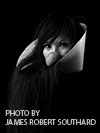 Pyuupiru (Japan, 1974). Lives and works in Tokyo. At the moment, she uses various media: installations, movies, performances, portraiture and sculpture. She works with opposed concepts like life-death, men-women, one-other. She participated in many exhibitions and performances, also on an international level. Besides being a contemporary artist, she works in a wide range of fields like art direction, character design, costume design and writing. You can see more of her work on: pyuupiru.com.
Pyuupiru (Japan, 1974). Lives and works in Tokyo. At the moment, she uses various media: installations, movies, performances, portraiture and sculpture. She works with opposed concepts like life-death, men-women, one-other. She participated in many exhibitions and performances, also on an international level. Besides being a contemporary artist, she works in a wide range of fields like art direction, character design, costume design and writing. You can see more of her work on: pyuupiru.com.The search of an ideal self
by Annemarie Bas
Speaking of the theme of this issue, Liquid Identity, one could say Pyuupiru is its embodiment. She was born as a male, but gradually realised that she didn’t feel comfortable with her body. She started wearing eccentric costumes that distorted her figure. And in 2007 she decided to take it a step further and get sex reassignment surgery, an experience that inspired her Self-portrait Series.
Identity, for Pyuupiru, is something that is constantly being developed and changed. In an interview she said:
“As time goes by, we grow both qualitatively and quantitatively, expanding our capacity. We continue to add various elements and new points of view to our personality, until we are like a bunch of grapes. I think this is the life of people from birth to death.”1
In this way, identity is not a fixed quality, one is constantly adding new elements to one’s personality, moulding it, giving it a new shape, perfecting it, searching for an ideal self. This process is not limited to the mind. The body can also be reshaped, so that it is in harmony with one’s identity.
Pyuupiru described the relationship between body and identity as follows:
“For me, the body is like a vase made of fragile glass. Liquid is an emotion of various colours poured in the vase, and identity is a will to make one pour the liquid into it. You know that the glass changes its shape when heat is added. And you know you choose what you wear by your will. Just like that I’ve transformed my body by my will, both internally and externally. It required me to reveal my very emotion. Emotion is just like a heat having various temperatures, and everyone has it.”2
The discord between body and mind, that Pyuupiru had felt since childhood, has been an incentive for her to make art. In her artistic work, her life experiences and emotions are vital. She keeps them bottled inside of her until they boil, provoking a creative explosion which is then transformed into art.
When she made the Self-portrait Series, she thought of the oppression she felt due to her gender dilemmas: first she thought of her memories and experiences of pain, such as her memories of boyhood and the nightmares caused by hormone replacement therapy and psychoactive drugs. She focused on them up to the point where she felt she had re-lived the suffering enough. Then she filtered those memories and experiences through her sense of beauty in order to be able to shape the characters in her work from the inside and the outside. After that, Pyuupiru, photographed and materialised these characters.
The result is a series of self-portraits which are very intense and personal (despite the fact that in some of the portraits she hides her face with cosmetics, wigs and masks). Exposing her true identity in this way, Pyuupiru tells us, came with a heavy price. Even so, she feels that an artist can gain a pleasure from this exploration that is beyond its costs. Therefore she will certainly continue to share her experiences and feelings through her art in a constant quest to come to grips with the mystery of identity.
1. Fleur Pierets, Pyuupiru in: Et Alors? Magazine, magazine special: GenderBlender (jun.-ago. 2014) 32-39, p.39.
http://issuu.com/etalorsmagazinespecials/docs/genderblender_issuu
2. Owen Leong, Interview with Pyuupiru in: Peril, Asian-Australian Arts and Culture, no. 8 - Why are people so unkind? (nov. 2009).
http://peril.com.au/back-editions/edition08/interview-with-pyuupiru/
 Annemarie Bas (The Netherlands, 1986), has a Bachelor’s degree in History at the University of Utrecht and a Master’s degree in Cultural History at the same institution. As a historian, she worked as a junior researcher at the Museum of Psychiatry "Het Dolhuys" in Haarlem, The Netherlands. Since 2013, she lives and works in Mexico City. At the moment, she is international liaison at ZoneZero and works as an independent translator.
Annemarie Bas (The Netherlands, 1986), has a Bachelor’s degree in History at the University of Utrecht and a Master’s degree in Cultural History at the same institution. As a historian, she worked as a junior researcher at the Museum of Psychiatry "Het Dolhuys" in Haarlem, The Netherlands. Since 2013, she lives and works in Mexico City. At the moment, she is international liaison at ZoneZero and works as an independent translator.







































 Pyuupiru (Japan, 1974). Lives and works in Tokyo. At the moment, she uses various media: installations, movies, performances, portraiture and sculpture. She works with opposed concepts like life-death, men-women, one-other. She participated in many exhibitions and performances, also on an international level. Besides being a contemporary artist, she works in a wide range of fields like art direction, character design, costume design and writing. You can see more of her work on: pyuupiru.com.
Pyuupiru (Japan, 1974). Lives and works in Tokyo. At the moment, she uses various media: installations, movies, performances, portraiture and sculpture. She works with opposed concepts like life-death, men-women, one-other. She participated in many exhibitions and performances, also on an international level. Besides being a contemporary artist, she works in a wide range of fields like art direction, character design, costume design and writing. You can see more of her work on: pyuupiru.com.



